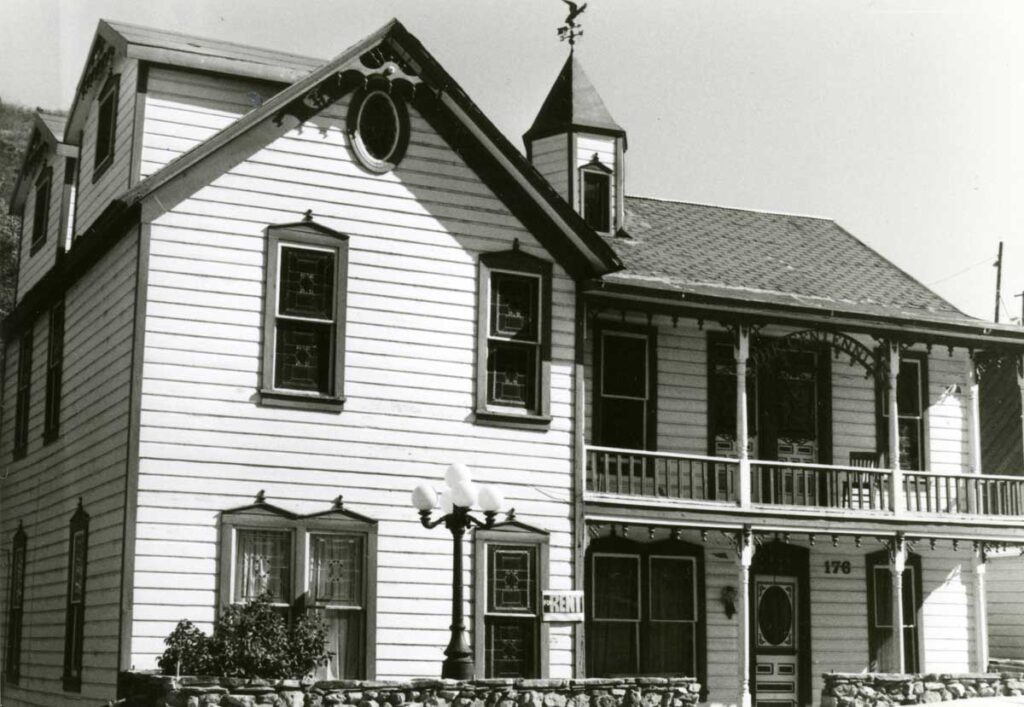One of only a few boarding houses from any part of town to survive until today, the Durkin Boarding House was an important source of housing in Park City’s mining days and its early skiing days.
It was built around 1901 after Utah passed a boarding house bill outlawing mining companies from requiring their single men to live in mine company housing. Prior to the law, single miners had to live in their mine’s boarding house – the rent for room and board was taken out of their paychecks each month. These boarding houses were located near the mines away from town. Miners were at the mercy of the mine companies and were also isolated from town life.
After the law, several boarding houses were built in town, and several other buildings converted to lodging. In October 1901, the Park Record reported that Joseph Durkin was “erecting a neat two-story residence on upper Main.” That building became 176 Main Street. Durkin ran it as a boarding house, while he and his family lived close by at 22 Prospect Avenue/Street.
Durkin came to Park City around 1876 and worked for the Ontario Mine just up the canyon from his home for over 25 years. He also served a stint on City Council. Unfortunately, he didn’t get to enjoy his transition from miner to boarding house operator for very long. He died in 1903 at 53 years old.
The Durkin family continued to run the boarding house until 1911. They sold to Joseph and Assunta Piva, who ran the business until 1918. That year, D.L.H. Grover, a prominent Chinese-American Parkite, bought the property, among many others. He died in 1926 leaving his many properties to his son, Joe, who often didn’t charge rent at his inherited properties during the Great Depression. Joe sold 176 Main Street to Hilda Johnson in 1930. She owned the property until 1964 and it appears she made it her home.

Credit: Park City Historical Society & Museum, Raye Ringholz Collection
The boarding house then had a variety of owners over the next 50 years. It became a cheap place to stay for ski bums working and playing at the resort in the 1970s, 1980s, and 1990s. Residents who lived in the building in this period recall the frequent and crazy parties, bombarding happy hour at the Hula Bowl across the street, and how haunted the building was.
Dale Nelson held the longest tenure as owner in the skier apartment period. Near the end of his time as owner in 2003, the building suffered a devastating flood from Poison Creek that ruined most of the lower level. Nelson sold to Judy Jackson of Chesa Fina in 2004. She had plans to turn the top floor into two luxury condos and the bottom floor into a restaurant. Although the plans were approved, they never materialized and she sold to Mountain Seas Development in 2006, who completely gutted the interior of the building.
The building has remained vacant since, with frequent commentary that the building is run down, derelict, should be renovated, etc. Unfortunately, the building remains in danger of demolition by neglect. Since it suffered a major flood and has sat vacant for nearly twenty years, the renovation costs are high. Despite that, the building retains its historic importance and landmark historic structure status. If restored, it would become one of Park City’s most beautiful buildings, rather than one if its current most unsightly. We hope the current owners restore the property, and soon. It means too much too much to our historic mining eras and holds plenty of crazy memories from our first ski eras.